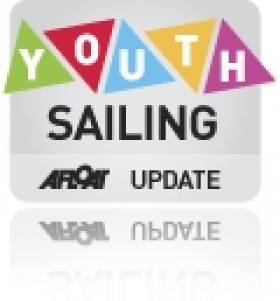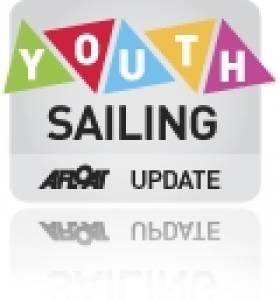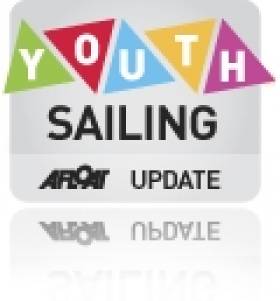Displaying items by tag: Sophie Murphy
Royal Cork Yacht Club sailors have lifted two national titles at the 2011 Mitsubishi National Youth Sailing Championships this afternoon in a series cut short today by gale force winds on Dublin Bay. SCROLL DOWN FOR THIS AFTERNOON'S PRIZEGIVING PHOTOS.
Local knowledge offered no advantage as Dun Laoghaire co-hosts the Royal St. George YC, the National Yacht Club and the Royal Irish YC won none of the five national titles inspite of strong turnouts fielded by each of the waterfront clubs.
With winds gusting up to 25-30 knots and easterly winds causing a big swell, sailing for the final day of the ISA Mitsubishi National Championships was cancelled leaving the 300 sailors ashore. However all classes had completed sufficient races to complete the series.
The event was an important test event for Dun Laoghaire organisers of the Youth Worlds which will be held in the same venue from 12 -21 July 2012.
In a show of strength from the regions the three other titles went to other east coast clubs at Howth, Ballyholme and Courtown.
Immediately after the prizegiving, (photos below) Olympic Team Manager James O'Callaghan named the Irish team for the 2011 ISAF Youth World Championships in Croatia in July based on the weekend results. Listen to the podcast with the team manager, talking about the stand out performances of the weekend, the current strength of youth sailing in Ireland and the prospect of a top finish in Croatia.
Royal Cork YC achieved two national titles with Laser 4.7 event favourite Seafra Guilfoyle winning the title having previously dominated the Optimist fleet in previous years.
Brother and sister team Patrick & Chloe Crosbie also from Royal Cork won the 420 National title and Patrick was awarded the Training Grant for the most promising sailor at the event.
This event was the national trials for the Optimist class which was won by Tralee Bay sailor Sophie Browne who will travel to New Zealand in December to compete in the Optimist World Championships.
Irish optimist sailors are performing well internationally at the moment finishing fourth and fifth at the Braassemermeer Easter regatta. Other events during 2011 where there will be Irish representation include the European Championships in Portugal and the National Championships in Germany and the UK.
Top three results below. Click the links for full results class by class.
Laser Radial - full results here
National Champion: Philip Doran (Courtown Sailing Club)
2nd Robbie Gilmore (Strangford Lough YC)
3rd Eoin Keller (Lough Derg YC)
1st Girl Sophie Murphy Quoile Yacht Club
Laser 4.7 - full results here
National Champion: Seafra Guilfoyle (Royal Cork YC)
2nd Darragh O'Sullivan (Kinsale YC)
3rd Finn Lynch (NYC/Blessington SC)
1st Girl: Sian Kneafsey (National YC)
420 - full results here
National Champions: Patrick Crosbie & Chloe Crosbie (Royal Cork YC)
2nd Aodh Kennedy & Daniel Browne (Kinsale YC & Tralee Bay SC)
3rd Emma Geary & Niamh Connolly (Royal Cork YC & Baltimore SC)
Feva - full results here
National Champions: D Johnston & L Flynn Byrne (Howth YC)
2nd C Totterdell & S Craig (National YC/Royal St. George YC)
3rd C Mollard & J Harris (Howth YC)
Topper - full results here
National Champion: T Brow (Ballyholme YC)
2nd Laura Gilmore (Strangford Lough YC)
3rd Andrew Penney (East Antrim BC)
Optimist (Championship fleet)
1st Ben Walsh (Skerries SC)
2nd Ross Quirke (National YC)
3rd Colin O'Sullivan (Malahide YC)
Optimist National Trials
Sophie Browne (Tralee Bay SC) won the trials and took the option of travelling to New Zealand in December 2011 to represent Ireland at the Optimist World Championships.
The following sailors were selected by the trial process to represent Ireland at the European Championship which will be held in Portugal in July 2011: Sean Donnelly, HYC, Peter McCann RCYC, Harry Whitaker RCYC, Eoin Lyden RCYC, Jil McGinley RCYC Cliodhna Ni Shuilleabhain KYC and Megan Parker SSC
The team selected to travel to the German National Championships include Robert Dickson HYC , Daire Cournane KYC, Sean Waddilove Skerries SC, Richard Hogan HYC, Adam Hyland RSGYC, Ronan Cournane KYC, Sean Gambier Ross KYC and Fergus Flood HYC, Aoife Hopkins and Alacoque Daly Tralee Bay SC.
In addition 10 sailors were chosen for the Irish under 12 squad who will compete in the Optimist UK National Championships.
All our youth sailing news aggregated here
Prizegiving photos by Gareth Craig below. For daily on the water action: Day one photos here. Day two photos here. Day three photos here.
300 Top Junior Sailors Bound for Dublin Bay
Over 300 sailors will compete in Dublin Bay in seven different classes (Laser Radial, Laser 4.7, 420, Feva, Topper, SL16 and Optimist). For youth sailors, this event is the most important in the annual calendar as it is the decider for the top Irish sailors to compete internationally during 2011 and is the pathway for future Olympic sailors. Podcast with Olympic Team Manager James O'Callaghan here.
The 420 fleet is already in situ as the Leinster Championships were held over Easter and the girls team Emma Geary and Niamh Connolly won the event in style. This team is the only 420 crew to qualify internationally for a place on the Irish team to compete in the ISAF Youth Worlds in Zadar, Croatia and will be looking to win next weekend to secure this honour.
Dublin Bay will host the 2012 ISAF Youth World Championships and this year's ISA Mitsubishi Youth National event is an important test event with representatives from the international sailing authority visiting Dun Laoghaire to view plans and test logistics.
In addition to the 420 fleet the Laser radial fleet will also be competing to qualify to represent Ireland in Croatia. Philip Doran aged 17 from Courtown in Wexford is the current former under 17 World Champion in the Laser Radial fleet although the National title has eluded him so far. In the girls fleet it will be a toss up between Saskia Tidey (RIYC) and Sophie Murphy (Quoile YC) as both already have a national title each under their belts.

A fleet of top Optimists are expected. Photo: Bob Bateman
The younger Optimist fleet is also celebrating this week after two top 5 positions at the Easter Regatta in Braassemermeer, the Netherlands. In fact an Irish team has competed at this event for 23 years and this is the first time that Ireland has won the country prize. Sean Donnelly from Dun Laoghaire who finished fourth in Braassemermeer is also leading the Optimist fleet in the trials and will be anxious to hold on to first position during the ISA Mitsubishi Youth Nationals.
In other fleets, the laser 4.7 fleet is enjoying record numbers with many ex-Optimist and Topper sailors choosing this boat. Finn Lynch from Blessington and Seafra Guilfoyle from Cork will be firm favourites to win the class.
Overall Dublin Bay will be a spectacle of sail over the May Bank holiday weekend with light winds forecast.
Mitsubishi Motors have been a proud supporter of junior sailing in Ireland for the last 7 years. In recent years Ireland has had successes at youth level with winner of the girls under 21 Laser World Championships and a top 10 at the 2010 ISAF Youth Worlds and wins at the British National Optimist Championships.
Doran Reigns In Junior All Ireland Event
It was a very long day of sailing in very light conditions for the Juniors on the second and final day of the All Ireland Junior Championship writes Claire Bateman. PRO Richard Leonard raced the fleet on the Curlane Bank in Cork harbour and was very fortunate to be able to get in three races in extremely difficult conditions.
The final result saw Philip Doran of Courtown Harbour SC taking first place with Rory Lynch of of Blessington Sailing Club second and Ross Vaughan of
Royal North of Ireland YC third.
In the Girls Fleet Sophie Murphy of Quoile YC took first place with Emma Geary of RCYC second and Katherine Geoghegan of Dungarvan Harbour SC third.
Photos of the Junior All Ireland Prizegiving and competition by Bob Bateman HERE.

































































